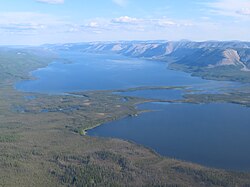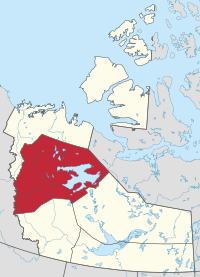Sahtu Region | |
|---|---|
 Norman Range and Kelly Lake | |
 Location within the Northwest Territories | |
| Country | Canada |
| Territory | Northwest Territories |
| Territorial riding | Sahtu |
| Settlement area | Sahtu |
| Regional office[1] | Norman Wells |
| Population (2016) | |
• Total | 2,554 |
| Time zone | UTC−07:00 (MST) |
| • Summer (DST) | UTC−06:00 (DST) |
The Sahtu Region is an administrative region in Canada's Northwest Territories. Coterminous with the settlement region described in the 1993 Sahtu Dene and Metis Comprehensive Land Claim Agreement, 41,437 km2 (15,999 sq mi) of the Sahtu is collectively owned by its Indigenous Sahtu (Dene) and Métis inhabitants. Although the region's population is predominantly First Nations, a significant non-Indigenous presence exists in Norman Wells, the regional office,[1] established in 1920 to serve the only producing oilfield in the Canadian Territories. Considered to be of vital strategic importance during World War II in the event of a Japanese invasion of Alaska, the region's petroleum resources were exploited by the United States Army with the Canol Project, but the pipeline never became necessary and ultimately operated for less than one year.

Since the abandonment of the Canol project, development within the region has been more limited than in the rest of the territory. Although plans have long existed for pipelines and highways to parallel the Mackenzie River through the Sahtu en route to the Arctic Ocean, the landmark Mackenzie Valley Pipeline Inquiry recommended that a moratorium be placed on construction until local Indigenous land claims could be settled. To this day, no all-weather roads connect the Sahtu with the rest of Canada, and the contiguous North American pipeline network finds its northernmost terminus at Norman Wells, which was connected to Zama City, Alberta in 1984. Ground transportation is seasonally provided by a network of winter and ice roads, while the abandoned Canol route now forms part of the Trans Canada Trail system.[3]
- ^ a b Sahtu Region
- ^ Government of the Northwest Territories. "About Municipal and Community Affairs". Retrieved 17 June 2019.
- ^ "Communities Of The Sahtu". The Sahtu Atlas. Sahtu Settlement Region, Northwest Territories: Sahtú Renewable Resources Board. 2024. ISBN 978-0-9737630-0-3. Retrieved 5 September 2024.
